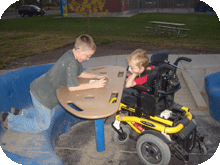
This mailer has been provided as an avenue to disperse information pertinent to public agencies and the landscape architecture profession in hopes of fostering greater understanding and collaboration. Topics address issues that affect the built environment within which we live.
UNIVERSAL DESIGN - PLAYGROUNDS
"You can discover more about a person in an hour of play than in a year of conversation." Plato
Universal play is based on the premise that all children are entitled to the experiences and opportunities provided by a playground. Observation of children's play patterns on universally accessible playgrounds will most often show that fully functional children prefer to play with equipment designed to assist children with disabilities. This is the intent, as all children learn to play together without preconceived notions of abilities and pre-established boundaries created by the designer. Universally accessible playgrounds should at a minimum address: ADA access and mobility impairments, cognitive delays, and sensory impairments.
ADA Access and Mobility Impairments: Contrary to common belief, access to play elements is beneficial not only to those confined to wheel chairs, but for mothers with strollers, the elderly, children with walking devices, and small children who are still learning how to navigate stairs and ladders. Play areas within the playground should incorporate ADA accessible safety surfacing to allow access to transfer stations, cozy spots, activity panels, rest areas, observation decks, and other play elements. All children, despite their level of mobility, should be able to participate in activities that promote self-directed play, provide movement and motion, and increase social interaction.
The next time you need a Landscape Architect on your project, consider O'Dell Engineering's Landscape Architecture Department.
Services include:
- Park and Playground Design
- Recreational Facility Design
- Site Planning
- Streetscape Design
- Urban Design
- Commercial Design
- 3-D Visualizations
- Graphic Design
Cognitive Delays: Cognitive delays are often overlooked; however they can be addressed simply in the design phases of a playground. Below are a few principles of cognitive delay inclusion that should be addressed:
- Provide clear, unimpeded sight lines of playground areas and landmarks. This allows children to easily locate themselves in the environment and also aids parents in supervision.
- Provide play elements in multiples to minimize social conflicts with sharing.
- Design contrast into play elements.(ie. High and low, Long and short)
- Design child sized cozy spots.
- Use consistent patterns and textures.
- Provide shaded transition areas where children can observe an activity before choosing to engage or not to engage.
- Include play activities that focus on repetition.
Sensory Impairments: Sensory impairments refer to children with visual, hearing, or other sensory impairments. These children, as do other children, benefit greatly through a few design principles carefully integrated into the landscape.
- Play areas should be rich with colors, textures, smells, sounds and sights.
- Play elements differing in height should be contrasting colors.
- Signs and play equipment should be embossed with letters and activities.
- Play areas for younger children should have narrower openings at platform openings and should be partially enclosed with fences to create a sense of security for these children and to limit typical wandering tendencies.
- Shaded areas should be provided for relief from the sun.
- Slides, other than a plastic slides (roller slide, etc.), should be included for children with sensitive electrical assistance devices.
These suggestions are just a few of the many design options that help create enjoyable playgrounds for everyone in the community. Communities can also take these principles a step further and have their playgrounds certified as a Boundless Playground®. The non-profit group Boundless Playgrounds assists communities and landscape architects with the process of fundraising, raising public awareness, design, and construction of universal playgrounds. A certified Boundless Playground has two requirements:
- A certified play structure which must include developmentally appropriate equipment and configurations, barrier free equipment, safety surfacing layout, and support of all children's development of life skills.
- A Boundless Playground Assessment must be conducted after construction which will also include registration in the "Go Play" program.
For more information about universal playgrounds and Boundless Playgrounds see the following links.




Author: Chad Kennedy, Landscape Architect
This informational article provided by O'Dell Engineering - 1165 Scenic Drive, Suite A, Modesto CA 95350
